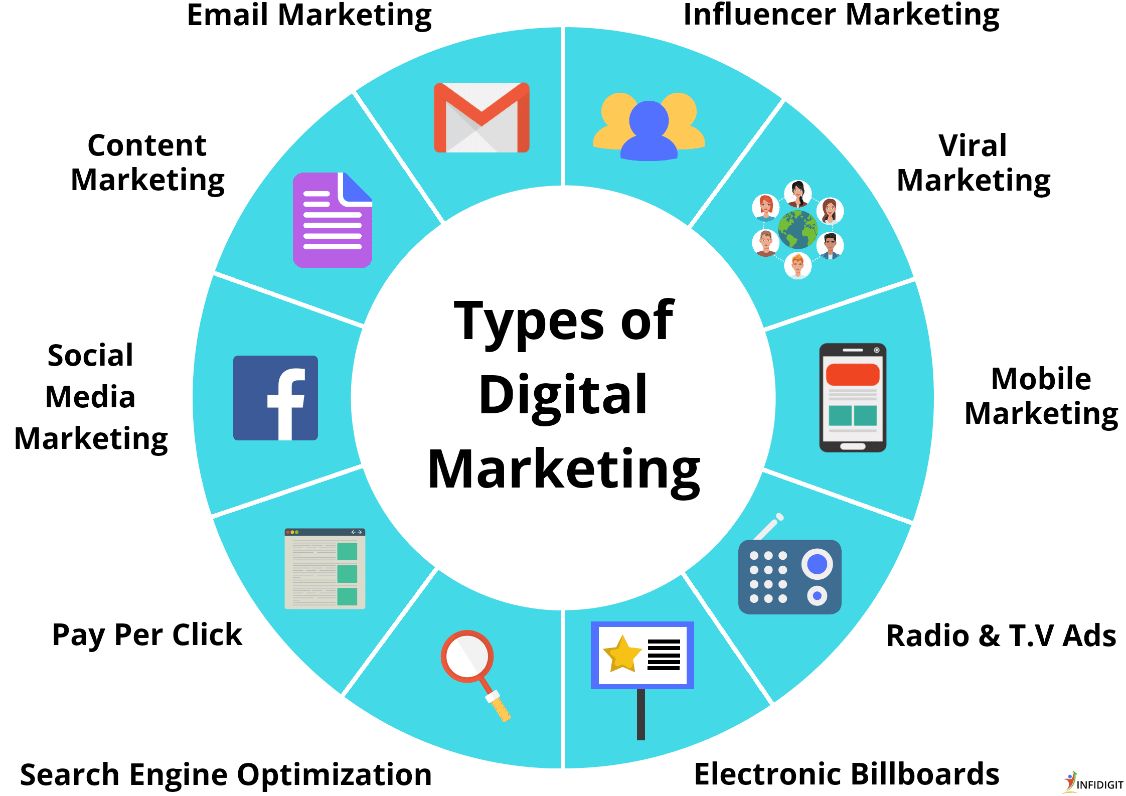
In the fast-paced digital era, where businesses vie for online attention, understanding the diverse landscape of digital marketing is crucial for success. This article explores various types of digital marketing strategies, each playing a unique role in building brand presence, engaging audiences, and driving conversions.
I. Search Engine Optimization (SEO): Elevating Visibility
- Overview:
- SEO is the practice of optimizing a website to rank higher on search engine results pages (SERPs), enhancing visibility and organic traffic.
- Key Components:
- Keywords, on-page optimization, link building, and content creation contribute to effective SEO strategies.
II. Search Engine Marketing (SEM): Paid Search Advertising
- Overview:
- SEM involves paid advertising on search engines, prominently displayed above organic results, contributing to immediate visibility.
- Key Components:
- Pay-Per-Click (PPC) campaigns, keyword targeting, and ad copy optimization are integral to SEM.
III. Content Marketing: Storytelling for Engagement
- Overview:
- Content marketing focuses on creating and distributing valuable, relevant content to attract and engage a target audience.
- Key Components:
- Blogs, articles, videos, and infographics are utilized to convey brand messages and establish authority.
IV. Social Media Marketing (SMM): Building Communities
- Overview:
- SMM involves leveraging social media platforms to connect with audiences, build brand awareness, and drive engagement.
- Key Components:
- Social media campaigns, influencer partnerships, and consistent content sharing contribute to effective SMM.
V. Email Marketing: Personalized Communication
- Overview:
- Email marketing focuses on building and nurturing relationships with leads and customers through targeted email campaigns.
- Key Components:
- Segmentation, personalization, automation, and analytics enhance the effectiveness of email marketing.
VI. Affiliate Marketing: Collaborative Partnerships
- Overview:
- Affiliate marketing involves partnering with affiliates who promote a product or service, earning a commission for each sale.
- Key Components:
- Affiliate networks, tracking systems, and performance-based incentives are crucial in affiliate marketing.
VII. Influencer Marketing: Harnessing Digital Influencers
- Overview:
- Influencer marketing involves collaborating with individuals who have a significant following to promote products or services.
- Key Components:
- Identifying influencers, building partnerships, and creating authentic content contribute to effective influencer marketing.
VIII. Video Marketing: Engaging Visual Content
- Overview:
- Video marketing utilizes engaging visual content to convey brand messages, tell stories, and connect with audiences.
- Key Components:
- Platforms like YouTube, IGTV, and TikTok, coupled with compelling storytelling, contribute to successful video marketing.
IX. Mobile Marketing: Targeting On-the-Go Consumers
- Overview:
- Mobile marketing tailors campaigns for mobile devices, considering the unique behaviors of on-the-go consumers.
- Key Components:
- Mobile-friendly websites, apps, SMS marketing, and location-based targeting are essential in mobile marketing.
X. Remarketing and Retargeting: Conversion Optimization
- Overview:
- Remarketing involves targeting users who have previously interacted with a website or app, encouraging them to return and convert.
- Key Components:
- Pixel tracking, personalized ads, and strategic messaging are critical elements of remarketing.
Conclusion:
In the vast digital marketing landscape, a comprehensive strategy often involves integrating multiple types to maximize reach and impact. Each type discussed in this guide brings its strengths to the table, and successful digital marketers understand the importance of a well-rounded approach that aligns with business goals and target audience behaviors. As businesses continue to navigate the dynamic digital landscape, staying informed about the diverse types of digital marketing will be key to staying ahead in the competitive online realm.


